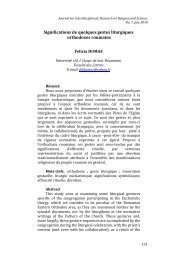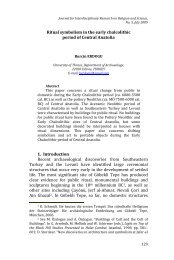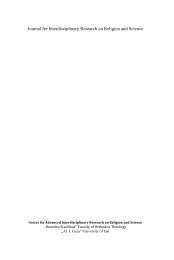Religious Dualism: Some Logical and Philosophical Difficulties
Religious Dualism: Some Logical and Philosophical Difficulties
Religious Dualism: Some Logical and Philosophical Difficulties
You also want an ePaper? Increase the reach of your titles
YUMPU automatically turns print PDFs into web optimized ePapers that Google loves.
AFLOROAEI - <strong>Religious</strong> <strong>Dualism</strong>: <strong>Some</strong> <strong>Logical</strong> <strong>and</strong> <strong>Philosophical</strong> <strong>Difficulties</strong><br />
represented by the twin genii; it is clear that the evil genius, Angra<br />
Mainyu, does not oppose his counterpart, Spanta Mainyu. The ethical<br />
dualism to be found in this double principle eventually compromises<br />
Zarathustra’s monotheism. He «combined monism with a strict<br />
dualism» so that «the monotheist tendency in Zarathustra’s doctrine can<br />
not be supported, as it is hindered by the dualism which clearly opposes<br />
it»” 49 . Absolute dualism seems to appear in the Mazdeist<br />
tradition, which succeeded Zoroastrianism <strong>and</strong> Manicheism.<br />
The two principles which confront each other in Mani’s<br />
religion appear as eternal not created principles, most often<br />
called Light <strong>and</strong> Darkness. These principles do not have an<br />
obvious common origin, <strong>and</strong> their confrontation seems to be<br />
endless. Nevertheless, Manicheist dualism is not radical in all<br />
its aspects. As Velasco observes, „radical dualism displays a certain<br />
inconsistency, as Augustin’s opponent confesses, «in our explanations<br />
one can never hear the names of two gods; it is true that we admit the<br />
existence of two principles, but only one of them is called God; the other<br />
is called matter or demon». This is clearly a weakened dualism<br />
(regarding the representation of the first principle) as compared to<br />
Zurvanism, in which Ahriman is considered not only a demon but a real<br />
God to whom people offer sacrifices” 50 . In general, the second<br />
power, which announces the existence of dualism, involves a<br />
context of creation <strong>and</strong> a really original creative power.<br />
However, dualist systems evolve in time <strong>and</strong> they may<br />
change significantly. “The more symmetrical a dualist system<br />
becomes, the less likely the supposition that the main creator co-exists<br />
with a secondary demiourgos; therefore, the dualist system gets closer<br />
to monism: the two principles become a single one, in which they coexist<br />
or from which they derive. In general, we believe that facts confirm<br />
Bianchi’s statement about the «monist vocation» of dualist systems” 51 .<br />
The opposite power tends either to condition the supreme<br />
divinity or to submit to its cosmic project. „In the first case, «the<br />
transcendence of the good in relation with the embodied evil tends to<br />
eliminate the transcendent distinction between God <strong>and</strong> the good<br />
creatures». In other words, transcendence does not refer to God in<br />
relation with his creation or with man, but to Pneuma, the spiritual part<br />
49 J. Martín Velasco, Introducción a la fenomenología de la religión,<br />
Ediciones Cristi<strong>and</strong>ad, S. L., Madrid, 1978, § II, 2b. The author quotes from<br />
Ugo Bianchi’s paper Monoteismo e dualismo in Zaratustra e nelle tradizione<br />
Mazdaica, published in“Studi e Materiali di Storia delle Religioni”, vol. XXVI,<br />
pp. 83-105.<br />
50 Ibidem.<br />
51 Ibidem.<br />
102





